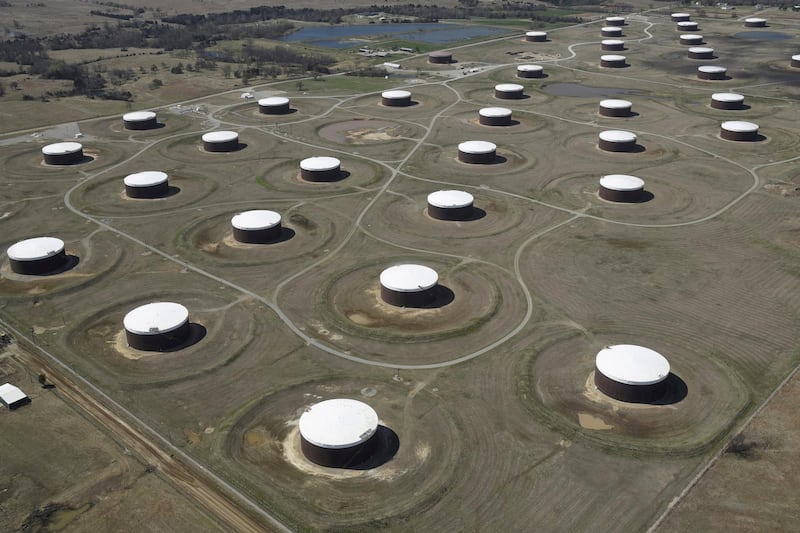As oil prices tumble, Opec countries meet in Vienna on December 6.
Before that, Russian President Vladimir Putin, Crown Prince Mohammed bin Salman of Saudi Arabia, and US President Donald Trump will meet at the G20 gathering in Argentina next week, along with Saudi energy supremo Khalid Al Falih and Russian oil czar Alexander Novak. The two key influencers will be elsewhere: supply and demand.
The current slump should not come as a shock. In the past two decades, something like this drop, down 30 per cent in less than 40 days, has happened six times before. As oil prices were ascending above $86 per barrel in early October, they were already beginning to look unsustainable. Brent crude fell below $60 on Friday.
The current drop is the market’s sudden realisation of what was already apparent: that high prices were sowing the seeds of their own destruction. Chinese demand has been slowing, amid some general signs of economic weakness. Oil prices in local currency terms had already reached record levels in important consuming countries such as India and Turkey. Demand destruction is not yet with us, but it was clearly looming.
The supply side has been comparably strong. In the middle of the year, the market seemed headed for shortage. The Opec-led production cuts had been more successful than expected, compounded by Venezuela’s economic collapse and harsh words from Washington about aiming to drive Iranian oil exports to zero via sanctions.
Saudi Arabia ramped up production pre-emptively as US president pressed on with his twitter attacks on Opec. Its November output is expected to be at an all-time record of 10.8 million to 10.9 million bpd. But the American decision to issue waivers to eight countries, two of which had already cut their oil imports from Iran almost to nothing, changed the narrative. Russia is playing coy on a return to production cuts; it may participate again, but the successful Opec+ structure has been disrupted.
The US itself is again the biggest contributor to a supply glut. Despite infrastructure constraints, year-on-year production growth in August was the highest ever, bigger even than in the boom years of 2011-14. Four new pipelines will open from West Texas’s Permian basin next year and three more in 2020, releasing a further flood and raising the prices realised by producers in the region, encouraging them to drill more. Net American oil imports next year could be edging close to zero for the first time since the 1940s.
Mr Trump is apparently making a cold political calculation in his calls for lower oil prices. The main producing states are almost all reliably Republican: Texas, Oklahoma, Alaska, North Dakota, Wyoming. Even though Texas these days is more of a battleground, the remarkably unlikeable Ted Cruz still beat rising Democrat star Beto O’Rourke in the latest senatorial elections.
As the US moves closer to self-sufficiency, the impact of lower oil prices on the economy overall is less clear than it used to be – it is probably close to neutral in the longer term. But most Americans benefit directly from lower oil prices, especially in the swing rust-belt states.
There are some important lessons for the major oil producers from this episode. Consumers do not have the tolerance for very high prices that they showed in the first decade of this century. India will be the key global source of future demand growth, but it is not the fuel-guzzling Chinese juggernaut of 2003-08. This will become ever more apparent as electric vehicles and liquefied natural gas-propelled ships gain momentum.
_______________
Read more:
US shale will be hurt the most from low oil prices, say analysts
Oil hits 2018 lows on emerging supply surplus
_______________
Conversely, despite the International Energy Agency’s frequent warnings of under-investment, oil production outside Opec remains extremely robust. This is mainly down to the United States. Opec’s targeting of unsustainable prices has built up a formidable competitor. Once the well-pads and pipelines and gas gathering systems are in place, American production will be able to grow even at lower prices and even as the “sweet spots” in the shales are tapped.
The major international oil companies have also trimmed costs during the 2014-17 slump, making deepwater developments viable again, with Guyana the most striking new area. The recent spike in prices did not live long enough to disturb their discipline.
While prices could well fall further from here in the near term, they will likely recover somewhat next year. The US will continue tightening the screws on Tehran, though Iran still has escape routes. If prices stay lower, it will encourage demand, though contending with headwinds of a trade war, Brexit and an economic expansion running out of puff.
The year 2020 will be interesting. A further flood of very light US oil will meet a market crying out for a heavier diet, of crudes suitable for making diesel and jet fuel, exacerbated by the regulations on shipping fuel that come into effect at the start of that year. The Middle East and Russia are the main suppliers of such grades of oil. Despite a market well supplied overall, refineries will have to work hard to spin straw into gold.
Abu Dhabi’s decision to expand its production capacity significantly by 2020 and again by 2030 against the longer-term backdrop, is correct. The market will need its crude and it will gain some paces on its competitors. Since short-lived attempts to keep prices above $80 to $100 per barrel have proved self-defeating, major producers do better to gain market share at moderate prices – and tailor their budgets accordingly.
Robin Mills is CEO of Qamar Energy, and author of The Myth of the Oil Crisis






